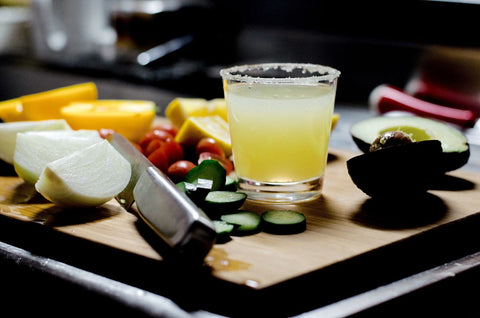What is malbec wine?
- Originally from France, grown in Argentina
- Can be used in a Bordeaux blend
- Oak-aged, fruity, and savory
- Famous for its hue
- Best served chilled
- Pairs easily with food
Anyone who's drunk some red wine before knows about the ever-popular Cabernet Sauvignon, Merlot, Pinot Noir. You may even know a thing or two about Zinfandels — but have you ever heard about Malbecs?
If not, we’re here to answer the question “what is Malbec wine, and how do I drink it?” After all, every red wine deserves its time in the spotlight — and this wine certainly deserves it this Malbec Day!
Read on to learn what makes this red wine so smooth and juicy, and the best ways to enjoy this delicious full-bodied red wine.
Originally from France, grown in Argentina

Malbec is nearly synonymous with Argentinian wine. In fact, the Malbec variety was considered a low-quality grape that should only be used in red wine blends. But, thanks to the advantageous growing conditions found in Argentina vineyards, Malbec wines were able to become the highly celebrated wine they are today.
Before it gained popularity in this region, however, it used to be grown in France, specifically the Cahors region. It’s still grown there today, but the bulk of Malbec wines shipped around the world hail from Argentina. And, the two taste very different — Argentinian bottles have a softer texture and a plummy taste, while French bottles are more tart.
The most notable Argentina wine region for producing some of the finest Malbecs out there is Mendoza. This region is perfect for the varietal, as vineyards are located at high altitudes, and exposed to plenty of sunshine year-round.
Malbec wines like our Norton Malbec Reserva 2018 — with notes of black fruit, spice, and violets — and our Trapiche Oak-Case Malbec 2019 — a fresh, fruity choice with touches of cherry and pepper — show the best of what this wine region has to offer.
Can be used in a Bordeaux blend
Though Malbec wines are a great drink on their own, their grapes are also a choice varietal when making certain red wine blends — such as Bordeaux. When we think of this blend, what comes to mind are typically the Cabernet Sauvignon, Cabernet Franc, and Merlot varietals. However, Malbecs also play well within this style and is another option approved for making Bordeaux red blends.
That being said, we don’t consider a Malbec to be primarily a blending grape anymore — thanks to the huge improvements the varietal has undergone after being cultivated in Argentina starting in the 18th century.
Oak-aged, fruity, and savory
Though the region that the wine was grown and made in will affect how each bottle of Malbec tastes, there are a few common tasting notes — even between French and Argentinian bottles.
This wine has pronounced jam-like fruit flavors, which are typically red or black fruits. This is highlighted by complementary savory notes, such as black pepper, tobacco, leather, and coffee.
When grown in warmer climates, dark fruit flavors are more prominent, such as those of plum and blackberry. In cooler-climate Malbecs, black cherry, and raspberry are common in the flavor profile.
Overall, Malbecs are well-loved for their smooth texture and slight hints of chocolate and cacao — courtesy of the oak aging process — which ties together its flavor profile perfectly. This wine is low on acidity, but still features a lot of structure. Some have described Malbecs to be a meaty-tasting wine thanks to its juicy and rich flavor profile.
Famous for its hue
Aside from its great flavors, Malbec is also known for its striking hue. Unlike most other red wines, its colors are deep and vivid purple. This comes from the pigmented, anthocyanin-rich grapes of the Malbec varietal. The Malbec varietal itself is almost a blue-black color, which is what gives its wine an almost inky quality.
Best served chilled
Contrary to popular belief, red wine shouldn’t always be served at room temperature — and Malbec wine is no exception.
Before serving any Malbec wine, make sure to pop it in the fridge for at least an hour to let it chill just below room temperature. This is ideal for you to experience this wine’s full depth of flavor.
We recommend serving Malbec in a wide-bowled glass. As it is a full-bodied wine, this glass type is best for experiencing the more rich and fruity flavors of the Malbec, while also softening the spice and balancing out the savory notes.
We also recommend decanting this wine. Malbec is one that certainly benefits from one — so before serving your bottle, try pouring it into a decanter and leave for around half an hour. Doing this will help aerate the wine, and enhance the flavors and aromas for drinking.
Pairs easily with food

Like many full-bodied red wines, Malbec is easy to pair with any kind of red meat. But unlike most, Malbec doesn’t feature an especially long finish, which also makes it suitable for pairing with leaner cuts of meat. Try pairing a Trapiche Iscay Malbec Cabernet Franc with lean cuts of beef, turkey, and chicken.
Oak-aged Malbecs, like our Kaiken Mai Malbec, offer lots of depth and delectable sweet cocoa notes, which makes them pair perfectly with desserts like Tiramisu. Generally, this wine will complement anything with coffee and chocolate flavors.
For Vegan wine lovers, don’t fret — there are plenty of food pairing options for you. Try it with blue cheese, or some couscous-stuffed roasted red peppers with your Malbec. Anything with pepper and olive oil can also work well to counteract the tannins and fruit-forward nature of the wine.
Key Takeaway
Knowing more about what Malbec wine is, then you know that this drink has lots to love. Its plump, dark fruit colors, savory and smoky finish, and surprising sweet chocolate and cocoa notes make it a delightful red wine to try.
If this article has got you interested in trying some Malbec, check out Ralph’s Wines & Spirits Malbec section the next time you make your wine run! Our bottles are available both online for delivery and in our stores — be sure to stop by!


